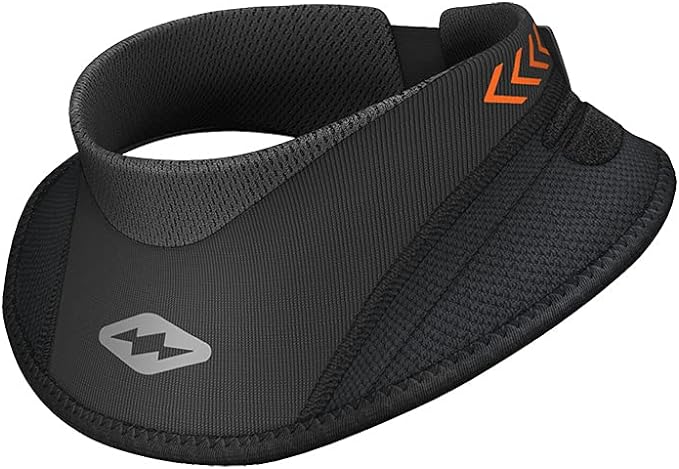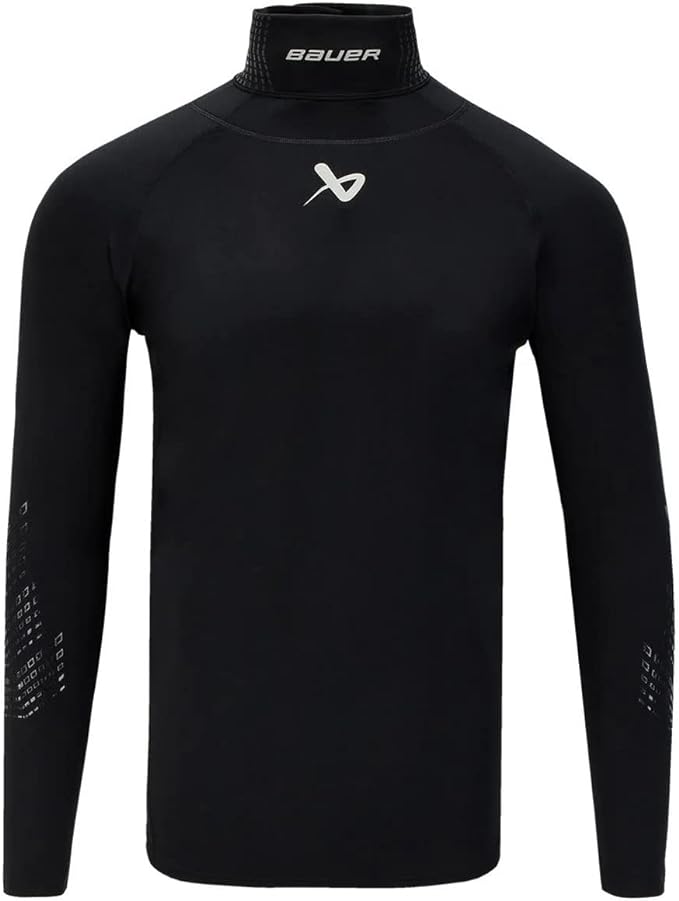Welcome to our essential guide on neck guards for youth hockey players. As youth hockey continues to grow in popularity, so does the focus on player safety. Recent updates from USA Hockey have placed a spotlight on the importance of protective gear, specifically neck guards, to ensure the well-being of our young athletes. Starting August 1, 2024, neck guards will be mandatory for all youth and junior players during games and practices, a significant step forward in our collective effort to enhance safety on the ice.
This guide aims to equip parents, coaches, and players with the knowledge needed to select, use, and maintain neck guards effectively, ensuring compliance with new regulations and, most importantly, fostering a safer environment for our players.
The Role of Neck Guards in Player Safety
The introduction of mandatory neck guard usage in youth hockey by USA Hockey underscores a critical aspect of player safety. The neck, with its vital arteries and the trachea, is one of the most vulnerable areas in a hockey player’s body. A laceration in this region can lead to severe consequences, making the protection provided by a neck guard invaluable.
Neck guards are specifically designed to prevent cuts and abrasions caused by skates, sticks, and pucks. While no piece of equipment can offer 100% protection against all injuries, the correct use of a neck guard significantly reduces the risk of potentially life-threatening neck injuries. The design and materials of modern neck guards aim to provide a balance between safety, comfort, and mobility, allowing players to focus on the game without feeling restricted.
Choosing the Right Neck Guard: Understanding Safety Certifications
When selecting a neck guard for youth hockey players, understanding the significance of safety certifications is crucial. While USA Hockey is working with the Hockey Equipment Certification Council (HECC) to develop a uniform standard for cut-resistant protective gear, including neck guards, there are already established standards in other regions that can serve as benchmarks for safety.
BNQ Certification (Canada)
In Canada, the Bureau de normalisation du Québec (BNQ) has set a specific standard for cut-resistant neck guards used in ice hockey and ringette. This certification ensures that neck guards have passed rigorous testing for cut resistance, including a specified amount of coverage and resistance to blade penetration during a standardized test. When looking for a neck guard, the BNQ certification is a solid indicator of a high level of protection, especially for players at risk of neck lacerations.
CE Marking (European Economic Area)
The Conformité Européenne (CE) certification is another key safety standard, relevant within the European Economic Area. CE marking on a neck guard indicates that the product complies with European safety regulations, covering aspects beyond just cut resistance. Although not specifically focused on hockey equipment, the CE marking signifies that a product meets high safety, health, and environmental protection requirements.
Implications for U.S. Players
For U.S. players, while HECC certification for neck laceration protection is still under development, recognizing and understanding the value of BNQ and CE certifications can guide purchasing decisions. These certifications are evidence of a product’s safety and effectiveness in providing cut-resistant protection. As USA Hockey continues to emphasize safety, looking for neck guards that meet these established international standards can be a proactive approach to ensuring player safety.
Types of Neck Guards: Features and Benefits
Selecting the right neck guard is essential for ensuring maximum protection and comfort for young hockey players. The market offers various types of neck guards, each designed to cater to different preferences and requirements. Understanding the features and benefits of each type can help you make an informed decision that ensures both safety and comfort for your athlete.
Wrap-around Neck Guards
These are the most popular type of neck guards, characterized by their simple design that wraps around the neck, typically securing with Velcro. Made from cut-resistant materials, wrap-around neck guards offer a good balance of protection and flexibility, making them ideal for players who want effective neck protection without extra bulk.
Bib-style Neck Guards
Bib-style neck guards offer extended coverage, not just around the neck but also partially covering the chest and back. This type is preferred for its enhanced protection area, safeguarding against impacts and cuts more effectively. It is particularly recommended for goalies or players who seek an additional layer of safety.
Long Sleeve Base Layer Shirt with Integrated Neck Protection
This innovative option integrates neck protection directly into a long sleeve base layer shirt. It’s designed for players who appreciate convenience and comfort, as it combines essential torso and arm coverage with neck protection in a single garment. This choice is excellent for ensuring consistent protection, as it eliminates the risk of the neck guard shifting during play. It also offers the added benefit of cut-resistant materials extending across the arms and torso, providing a more comprehensive protective solution.
How to Choose the Right Neck Guard
In selecting a neck guard, consider these key factors to ensure the best choice for your player’s safety and comfort:
- Size and Fit: A neck guard should fit snugly around the neck without being too restrictive or too loose. Measure the player’s neck according to the manufacturer’s sizing instructions.
- Material: Opt for materials that offer both cut-resistance and comfort. High-quality options include Kevlar and ballistic nylon, known for their durability and protective capabilities.
- Comfort and Mobility: The neck guard should not impede the player’s head movement or cause discomfort during play. Choose a design that allows for a full range of motion.
- Certification: Look for certifications like BNQ in Canada and CE in Europe, which indicate compliance with specific safety standards. While awaiting HECC certification for neck guards, these certifications can serve as a quality and safety benchmark.
- Adjustability: Adjustable features, such as Velcro straps, can enhance the fit and provide flexibility to accommodate growth or preference changes.
Choosing the right neck guard is a balance between ensuring optimal safety and maintaining comfort and mobility on the ice. By carefully considering these factors, you can select a neck guard that best protects your young player while allowing them to perform at their best.
Ensuring a Proper Fit: A Step-by-Step Guide
A well-fitting neck guard is essential for effective protection. Here’s how to ensure your youth hockey player’s neck guard fits correctly, providing the best combination of safety and comfort.
Measuring for the Right Size
- Measure the Neck: Using a soft tape measure, determine the circumference of the player’s neck. Place the tape measure snugly around the neck, just below the Adam’s apple, where the neck guard will sit.
- Consult the Size Chart: Match the measurement to the manufacturer’s size chart for the neck guard. If between sizes, consider the fit preference of the player (tighter for more security, looser for comfort) but avoid choosing a size that compromises protection.
Checking the Fit
- Wrap-Around Neck Guards: Secure the neck guard around the neck, ensuring the Velcro is fastened so it feels snug but not constrictive. The guard should sit comfortably around the entire neck without gaps, offering full coverage from all angles.
- Bib-style Neck Guards: In addition to checking the neck fit, ensure the bib covers the upper chest and back adequately. Adjust any straps or fittings to minimize movement and provide stable protection.
- Long-Sleeve Base Layer Shirt with Integrated Neck Protection: Ensure the base layer fits snugly against the body, with the integrated neck protection fitting similarly to a stand-alone neck guard. The shirt should allow for full range of motion without the fabric bunching or the neck protection shifting.
Adjustment Tips
- Velcro Straps: Use Velcro straps to adjust the fit as needed. The goal is to achieve a balance between a secure fit that prevents the guard from moving during play and enough looseness to avoid discomfort or breathing restrictions.
- Growth Considerations: For growing players, regularly re-measure and adjust the fit of the neck guard, especially at the start of a new season or if the player has experienced a growth spurt.
Final Check
Have the player move their head in all directions (nodding, shaking, looking up and down) to ensure the neck guard stays in place without sliding or causing discomfort.
Check that the neck guard does not restrict breathing or swallowing. A correctly fitted neck guard will be noticeable but not uncomfortable or obstructive.
Maintenance and Care Tips
To ensure the neck guard continues to offer optimal protection and maintains its condition, regular maintenance and care are essential. Here’s how to keep the neck guard in top shape:
Cleaning the Neck Guard
- Follow Manufacturer’s Instructions: Always refer to the care instructions provided by the manufacturer. Different materials may require specific care methods.
- Regular Cleaning: After each use, it’s advisable to clean the neck guard to remove sweat and bacteria. Most neck guards can be hand-washed with mild soap and lukewarm water. Allow it to air dry completely before the next use.
- Avoid Harsh Chemicals: Do not use bleach or other harsh chemicals that can degrade the materials and reduce the protective capabilities of the neck guard.
Drying the Neck Guard
- Air Dry: Lay the neck guard flat or hang it in a well-ventilated area away from direct sunlight and heat sources. This prevents material breakdown and ensures the neck guard retains its shape and protective qualities.
- No Machine Drying: Unless specified by the manufacturer, avoid using a tumble dryer as the heat can damage the materials, affecting their fit and protection.
Storage
- Keep it Flat: Store the neck guard flat or in a shape-preserving manner to avoid creases or damage. Ensure it’s fully dry before storing it to prevent mold or mildew growth.
- Cool, Dry Place: Store in a cool, dry place away from direct sunlight, which can degrade materials over time.
Regular Inspections
- Check for Wear and Tear: Regularly inspect the neck guard for signs of wear, such as fraying, tears, or significant deformation. These can compromise the guard’s protective abilities.
- Replace When Necessary: If you notice any damage or if the neck guard no longer fits properly, it’s time for a replacement. Regular wear and growth spurts can alter the fit, making replacements necessary to ensure safety.
Recommended Neck Guards
There is a lot of information in this guide that is designed to help you determine which neck guard to purchase for your player. However, we have narrowed down our recommended products that we feel give you the most value and safety. The following neck guards have been used by our players, and feedback from players and families were considered.
One thing I will note when speaking to my son, who has used both the baselayer shirt and the collar is that he prefers the collar because its less of a pain if he forgets to put his base layer on. Instead of having to take all of his upper body pads off, he likes that he can just wear the collar around his neck.

SHOCK DOCTOR ULTRA 2.0 NECK GUARD
- Lightweight, Flexible, and Contoured to enhance comfort.
- Cut Resistant Material
- BNQ Certified

BAUER NeckProtect LONG SLEEVE BASELAYER
- Dupont Kevlar brand fibers
- Hei! Fresh Technology and Smart Temp Technology
- BNQ and CE Certified





